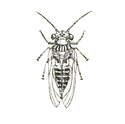Superregnum: Eukaryota
Cladus: Unikonta
Cladus: Opisthokonta
Cladus: Holozoa
Regnum: Animalia
Subregnum: Eumetazoa
Cladus: Bilateria
Cladus: Nephrozoa
Cladus: Protostomia
Cladus: Ecdysozoa
Cladus: Panarthropoda
Phylum: Arthropoda
Subphylum: Hexapoda
Classis: Insecta
Cladus: Dicondylia
Subclassis: Pterygota
Cladus: Metapterygota
Infraclassis: Neoptera
Cladus: Eumetabola
Cladus: Paraneoptera
Superordo: Condylognatha
Ordo: Hemiptera
Subordo: Sternorrhyncha
Superfamiliae: Aleyrodoidea - Aphidoidea - Coccoidea - †Genaphidoidea - †Lutevanaphidoidea - †Naibioidea - †Palaeoaphidoidea - Phylloxeroidea - Psylloidea - †Tajmyraphidoidea - †Triassoaphidoidea
Genera incertae sedis: †Anconatus – †Aphidinius – †Aphidioides – †Canaphis – †Dataiaphis – †Dubiaphis – †Echinaphis – †Geranchon – †Holmaniella – †Jurocallis
References
Martin, J.H.; Lau, C.S.K. 2011: The Hemiptera-Sternorrhyncha (Insecta) of Hong Kong, China—an annotated inventory citing voucher specimens and published records. Zootaxa, 2847: 1–122. Preview
Vernacular names
čeština: mšicosaví
Deutsch: Pflanzenläuse
日本語: 腹吻亜目
polski: piersiodziobe
The Sternorrhyncha[1][2][3] suborder of the Hemiptera contains the aphids, whiteflies, and scale insects, groups which were traditionally included in the now-obsolete order "Homoptera". "Sternorrhyncha" refers to the rearward position of the mouthparts relative to the head.
Distributed worldwide, all members of this group are plant-feeders (phytophagous), and many are major crop and ornamental pests.
Many exhibit modified morphology and/or life cycles, including phenomena such as flightless morphs, parthenogenesis, sexual dimorphism, and eusociality.
Phylogeny
The phylogeny of the extant Sternorrhyncha, inferred from analysis of small subunit (18S) ribosomal RNA, is shown in the cladogram.[4]
| Sternorrhyncha |
|
The evolutionary position of several fossil taxa are unclear. A suggested phylogeny is:[5][6]
|
Groups
Well-known groups in the Sternorrhyncha include:
aphids – (Aphididae)
woolly and gall-making aphids (Eriosomatinae)
pine and spruce aphids (Adelgidae)
phylloxerans (Phylloxeridae, including the vine phylloxera)
whiteflies – (Aleyrodidae)
jumping plant lice (Psyllidae and allied families)
Superfamily Coccoidea (scale insects)
cottony cushion scales, giant coccids, and ground pearls (Margarodidae)
armoured scales (Diaspididae)
cochineal insects (Dactylopiidae)
lac scales (Kerriidae, Lacciferidae, Tachardinidae)
soft scales (Coccidae)
pit scales (Asterolecaniidae)
mealybugs (Pseudococcidae)
felted scales (Eriococcidae)
References
"ITIS standard report - Sternorrhyncha". Integrated Taxonomic Information System. Retrieved 27 July 2014.
Grimaldi & Engel (2005) Evolution of the Insects 289-303.
Paraneoptera Species File (Version 5.0/5.0)
"Phylogeny of Insects". What-When-How. Retrieved 21 February 2018.
Drohojowska, Jowita; Szwedo, Jacek; Żyła, Dagmara; Huang, Di-Ying; Müller, Patrick (2020). "Fossils reshape the Sternorrhyncha evolutionary tree (Insecta, Hemiptera)". Scientific Reports. 10 (1): 11390. doi:10.1038/s41598-020-68220-x. ISSN 2045-2322. PMC 7347605. PMID 32647332.
Szwedo, Jacek (2016). "The unity, diversity and conformity of bugs (Hemiptera) through time". Earth and Environmental Science Transactions of the Royal Society of Edinburgh. 107 (2–3): 109–128. doi:10.1017/S175569101700038X. ISSN 1755-6910. S2CID 134243346.
Retrieved from "http://en.wikipedia.org/"
All text is available under the terms of the GNU Free Documentation License





